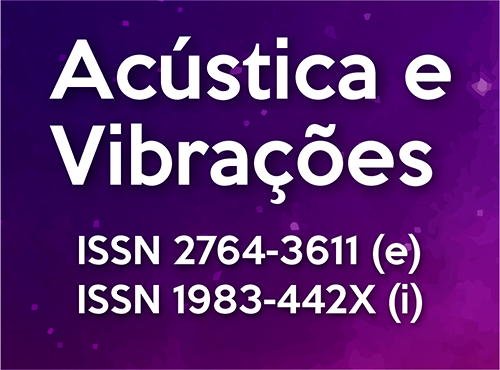Técnica rápida para geração de aurilizações utilizando redes neurais artificiais
DOI:
https://doi.org/10.55753/aev.v33e50.84Palavras-chave:
realidade virtual acústica, aurilização em salas, geração de BRIRs, redes neurais artificiais, simulação de campo acústico em salas, índice de articulaçãoResumo
Um dos objetivos do desenvolvimento e do aperfeiçoamento de técnicas numéricas em sistemas de geração de realidade virtual acústica e produção de aurilizações fidedignas, consiste na redução do custo computacional e, simultaneamente, garantir a qualidade sonora da simulação. Neste artigo, é apresentada uma nova técnica para modelar as funções de transferência associadas à cabeça humana, necessárias ao cômputo das respostas impulsivas biauriculares. São utilizadas redes neurais artificiais do tipo funções de base radial. Um conjunto dessas redes é treinado e testado de modo a cobrir todo o espaço auditivo no entorno da cabeça. Cada rede neural para uma dada direção tem como entrada o espectro da frente de onda sonora que atinge o receptor e, como saída, a resposta impulsiva associada à cabeça humana filtrada, para a direção correspondente. Desse modo, trabalha-se diretamente no domínio do tempo, contornando-se a necessidade de convoluções com uma redução do custo computacional em cerca de 90%. A técnica proposta é comparada com o método das convoluções, tanto no domínio do tempo como no domínio da frequência. Os resultados simulados demonstram a eficiência da técnica proposta, com valores de correlação bem próximos de um. Para validar o resultado, testes preliminares utilizando índices de articulação para comparar a percepção da fala em uma sala real e na mesma sala simulada computacionalmente utilizando a modelagem das respostas impulsivas filtradas aqui descrita foram conduzidos, com resultados plenamente satisfatórios.
Referências
VORLÄNDER, M. Auralization: Fundamentals of Acoustics, Modelling, Simulation, Algorithms and Acoustic Virtual Reality. Berlin: Springer-Verlag, 2008. doi: 10.1121/1.2908264 DOI: https://doi.org/10.1121/1.2908264
KLEINER, M.; DALENBÄCK, B.I.; SVESSON, P. Auralization - an overview. J. audio Eng. Soc, 41, p.861, 1993.
BLAUERT, J. Spatial Hearing. Cambridge: The MIT Press, 1997. doi: 10.7551/mitpress/6391.001.0001 DOI: https://doi.org/10.7551/mitpress/6391.001.0001
RINDEL, J. The use computer modeling in room acoustics. Journal of Vibro engeneering, 4(3):41–72, 2000.
TENENBAUM, R.A.; CAMILO, T.S.; TORRES, J.C.B. and GERGES, S.Y. Hybrid method for numerical simulation of room acoustic: Part 1 – theorical and numerical aspects. J. Braz. Soc. Mech. Sci. Engin., 29(2):211–221, 2007a. DOI: https://doi.org/10.1590/S1678-58782007000200012
BORK, I. Report on the 3rd Round Robin on room acoustical computer simulation - Part II: Calculations. Acta Acustica united with Acustica, 91(4):753–763, 2005.
SAVIOJA, L.; SVENSSON, U.P. Overview of geometrical room acoustic modeling techniques. J. Acoust. Soc. Am, 138(2):708–730, 2015 doi: 10.1121/1.4926438 DOI: https://doi.org/10.1121/1.4926438
EMBRECHTS, J. Randomly traced sound ray techniques. Acustica, 51:285–295, 1982.
KULOWSKI, A. Algorithmic representation of the ray tracing technique. Applied Acoustics, 18:449–469, 1984. doi: 10.1016/0003-682X(85)90024-6 DOI: https://doi.org/10.1016/0003-682X(85)90024-6
ONDET, M; BARBRY, J.L. Modeling of sound propagation in fitted workshops using ray tracing. J. Acoust. Soc. Am., 85(2):787–796, 1989. doi: 10.1121/1.397551 DOI: https://doi.org/10.1121/1.397551
FARINA, A. RAMSETE – a new pyramid tracer for medium and large-scale acoustic problems. Proceedings of the Euronoise, Lyon, 1995
ALLEN, J.B.; BERKLEY, D.A. Image method for efficiently simulating small-room acoustics. J. Acoust. Soc. Am., 65, p. 943, 1979. doi: 10.1121/1.382599 DOI: https://doi.org/10.1121/1.382599
DALENBÄCK, B; KLEINER, M.; SVENSON, P. A macroscopic view of diffuse reflection. J. áudio Eng. Soc. 42:793–807, 1994.
KURZINS, E.; FRICKE, F. The prediction of sound fields in non-diffuse spaces by random walk approach. J. Sound and Vib., 81(4):549–564, 1982. doi: 10.1016/0022-460X(82)90296-6 DOI: https://doi.org/10.1016/0022-460X(82)90296-6
ALARCÃO, D.; BENTO COELHO, J.L.; TENENBAUM, R.A. On modeling of room acoustics by a sound energy transition approach. Proceedings of EEA Symposium on Architectural Acoustics, 2000.
GARDNER, B.; MARTIN, K. HRTF Measurements of a KEMAR Dummy-Head Microphone. J. Acoust. Soc. Am., vol. 97, n. 6, pp. 3907– 3908, 1995. DOI: https://doi.org/10.1121/1.412407
BRINKMANN, F.; LINDAU, A.; WEINZIERL, S.; VAN DER PAR, S.; OPDAM, R.; VORLÄNDER, M. The FABIAN head-related transfer function database. doi: 10.14279/depositonce-5718.2, 2017.
MILLS, A. On the minimum audible angle. J. Acoust. Soc. Am., 30:237–246, 1958. doi: 10.1121/1.1909553 DOI: https://doi.org/10.1121/1.1909553
KISTLER, D. J.; WIGHTMAN, F.L. A model of head-related transfer functions based on principal components analysis and minimum-phase reconstruction. J. Acoust. Soc. Am. 91(3), 1637–1647, 1992. doi: 10.1121/1.402444 DOI: https://doi.org/10.1121/1.402444
TORRES, J.C.B; PETRAGLIA, M.R.; TENENBAUM, R.A. An efficient wavelet based HRTF model for auralization. Acta Acustica united with Acustica, 90(1):108−120, 2004.
HU, H.; ZHOU, L.; MA, H.; WU, Z. HRTF personalization based on artificial neural network in individual virtual auditory space. Applied Acoustics, 69(2):163–172, 2008. doi: 10.1016/j.apacoust.2007.05.007 DOI: https://doi.org/10.1016/j.apacoust.2007.05.007
TENENBAUM, R.A.; TAMINATO, F.O.; MELO,V.S.G.; TORRES, J.C.B. Auralization generated by modeling HRIRs with artificial neural networks and its validation using articulation tests. Applied Acoustics, 130, pp. 260–269, 2018. doi: 10.1016/j.apacoust.2017.09.025 DOI: https://doi.org/10.1016/j.apacoust.2017.09.025
BROOMHEAD, D.; LOWE, D. Multivariable functional interpolation and adaptive networks. Complex Systems, 2:321–355, 1988.
LI, L.; HUANG, Q. HRTF personalization modeling based on RBF neural network. Proceedings of IEEE International Conference on Acoustics, Speech and Signal Processing, p. 3707–3710, Vancouver, Canada, 2013. doi: 10.1109/ICASSP.2013.6638350 DOI: https://doi.org/10.1109/ICASSP.2013.6638350
TENENBAUM, R.A.; CAMILO, T.S.; TORRES, J.C.B. and STUTZ, L.T. Hybrid method for numerical simulation of room acoustic: Part 2 – validation of the computational code RAIOS 3. J. Braz. Soc. Mech. Sci. Engin., 29(2):223–231, 2007b. doi: 10.1590/S1678-58782007000200013 DOI: https://doi.org/10.1590/S1678-58782007000200013
FERNANDES, K.M.; TENENBAUM, R.A.; STUTZ, L.T. Problema inverso em propagação de ondas em sólidos com aplicação de método híbrido de otimização. Em: Técnicas de Inteligência Computacional com Aplicações em Problemas Inversos de Engenharia. Editora Omnipax, Curitiba, pp. 51–66, 2014. DOI: https://doi.org/10.7436/2014.tica.05
RAHIM, M.G., GOODYEAR, C.C. and KLEIJN, W.B. On the use of neural networks in articulatory speech synthesis. J. Acoust. Soc. Am., v. 93(2):1109–1121, 1992. DOI: https://doi.org/10.1121/1.405559
HAYKIN, S. Neural Networks and Learning Machines. 3rd Edition, Prentice Hall, New Jersey, 2009.
TAMINATO, F.O. Redes neurais artificiais aplicadas à modelagem de respostas impulsivas associadas à cabeça humana para gerar aurilização. Tese de doutorado, Programa de Pós-graduação em Modelagem Computacional, Universidade do Estado do Rio de Janeiro, 2018.
TENENBAUM, R.A.; TAMINATO, F.O.; MELO V.S.G. Fast auralization using radial basis functions type of artificial neural network techniques. Applied Acoustics, 157, 106993, 2020. doi: 10.1016/j.apacoust.2019.07.041 DOI: https://doi.org/10.1016/j.apacoust.2019.07.041
A Ground Truth for Room Acoustic Simulation. Outubro 2019. doi.org/10.14279/depositonce-6726
HODGSON, M.; YORK, N.; YANG, W.; BLISS, M. Comparison of predicted, measured, and auralized sound fields with respect to speech intelligibility in classrooms using CATT-acoustic and ODEON. Acta Acustica united with Acustica, 94(6):883–890, 2008. doi: 10.3813/AAA.918106 DOI: https://doi.org/10.3813/AAA.918106
MELO, V. S. G.; TENENBAUM, R. A.; NARANJO, J. F. L. A new approach to validate computer modeling auralizations by using articulation indexes. Acústica & Vibrações, Vol. 46, pp. 1−8, 2014. doi: 10.55753/aev.v29e46.125
POLLOW, M.; BEHLER, G. Variable directivity for platonic sound sources based on spherical harmonics optimization. Acta Acustica united with Acustica, 95(6):1082–1092, 2009. doi: 10.3813/AAA.918240 DOI: https://doi.org/10.3813/AAA.918240
KLEIN, J.; POLLOW, M.; VORLÄNDER, M. Optimized spherical sound source for auralization with arbitrary source directivity. Proceedings of the EAA Joint Symposium on Auralization and Ambisonics, p.56–61, Berlin, 2014. doi: 10.14279/depositonce-10
LINDAU, A.; ERBES, V.; LEPA, S.; MAEMPEL, H.J.; BRINKMANN, F.; WEINZIERL, S. A spatial audio quality inventory for virtual acoustic environments (SAQI). Acta Acustica united with Acustica, 100(5):984–994, 2014. doi: 10.3813/AAA.918778 DOI: https://doi.org/10.3813/AAA.918778
MELO, V. S. G.; LIMA, P. G.; SANTOS, T. C.; TENENBAUM, R. A. Validação de realidade virtual acústica via testes de articulação em salas ruidosas e reverberantes. Acústica & Vibrações, 49, pp. 51–57, 2017. doi: 10.55753/aev.v32e49.95 DOI: https://doi.org/10.55753/aev.v32e49.95

Downloads
Publicado
Como Citar
Edição
Seção
Licença
Copyright (c) 2018 Acústica e Vibrações

Este trabalho está licenciado sob uma licença Creative Commons Attribution-NonCommercial-ShareAlike 4.0 International License.




